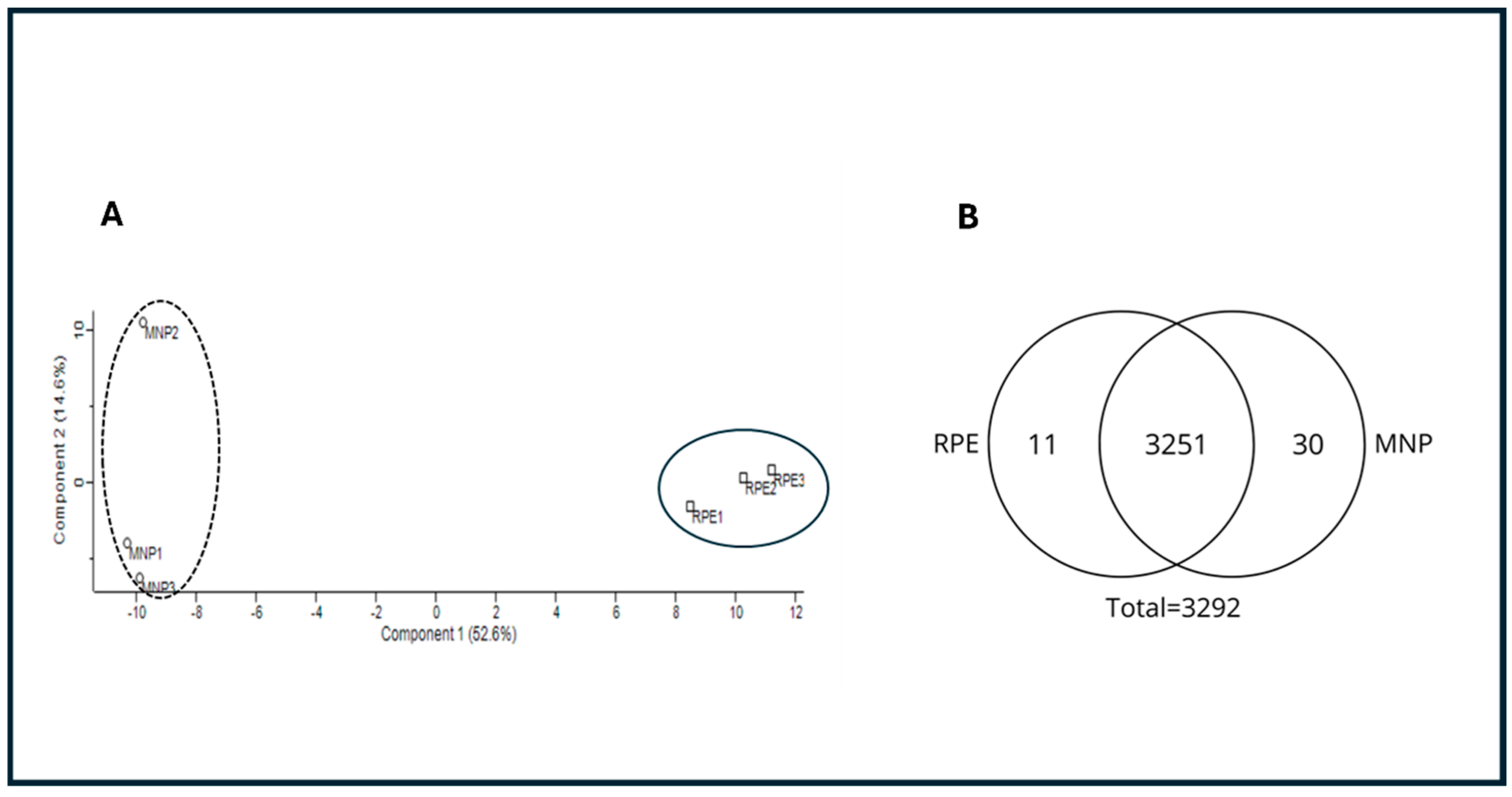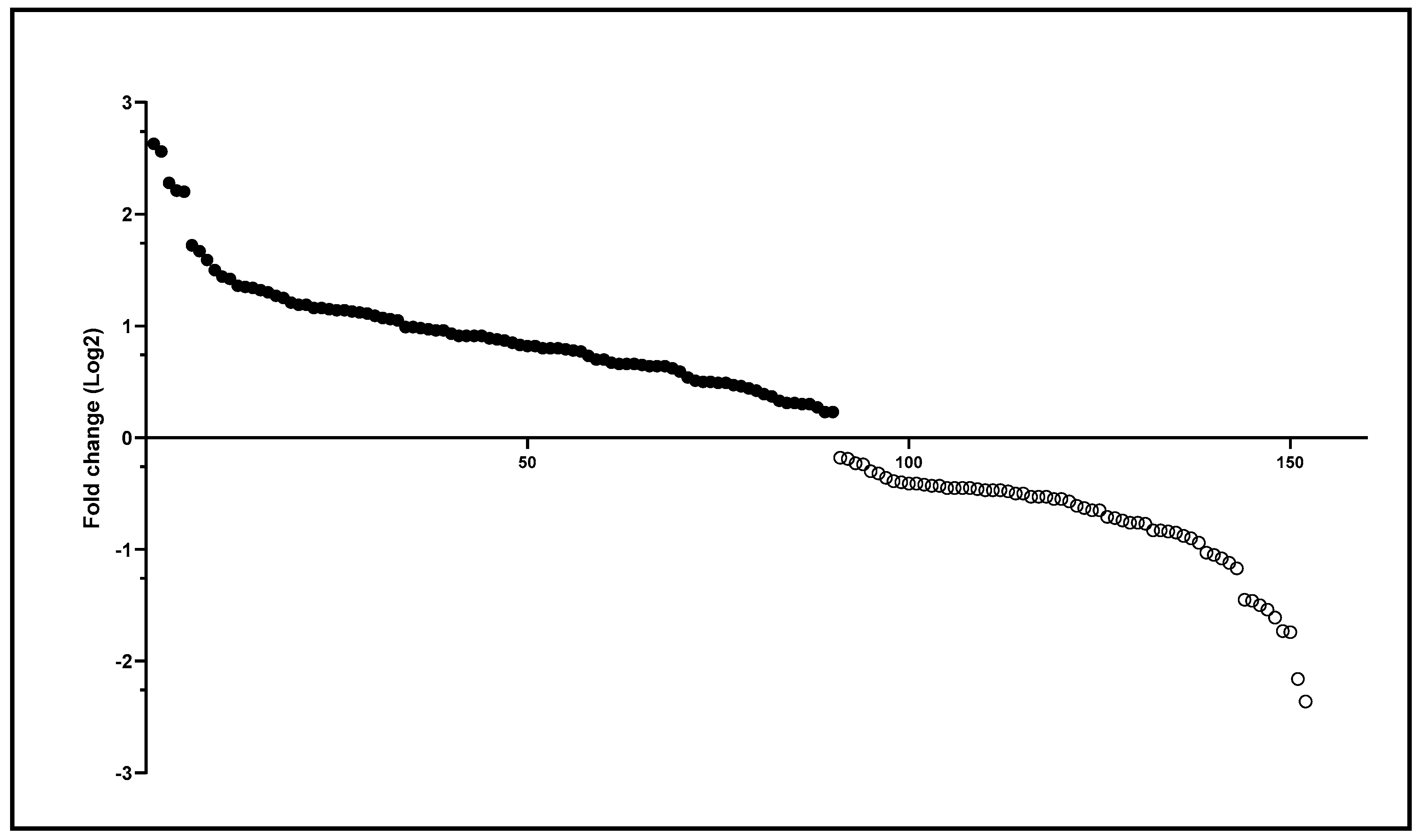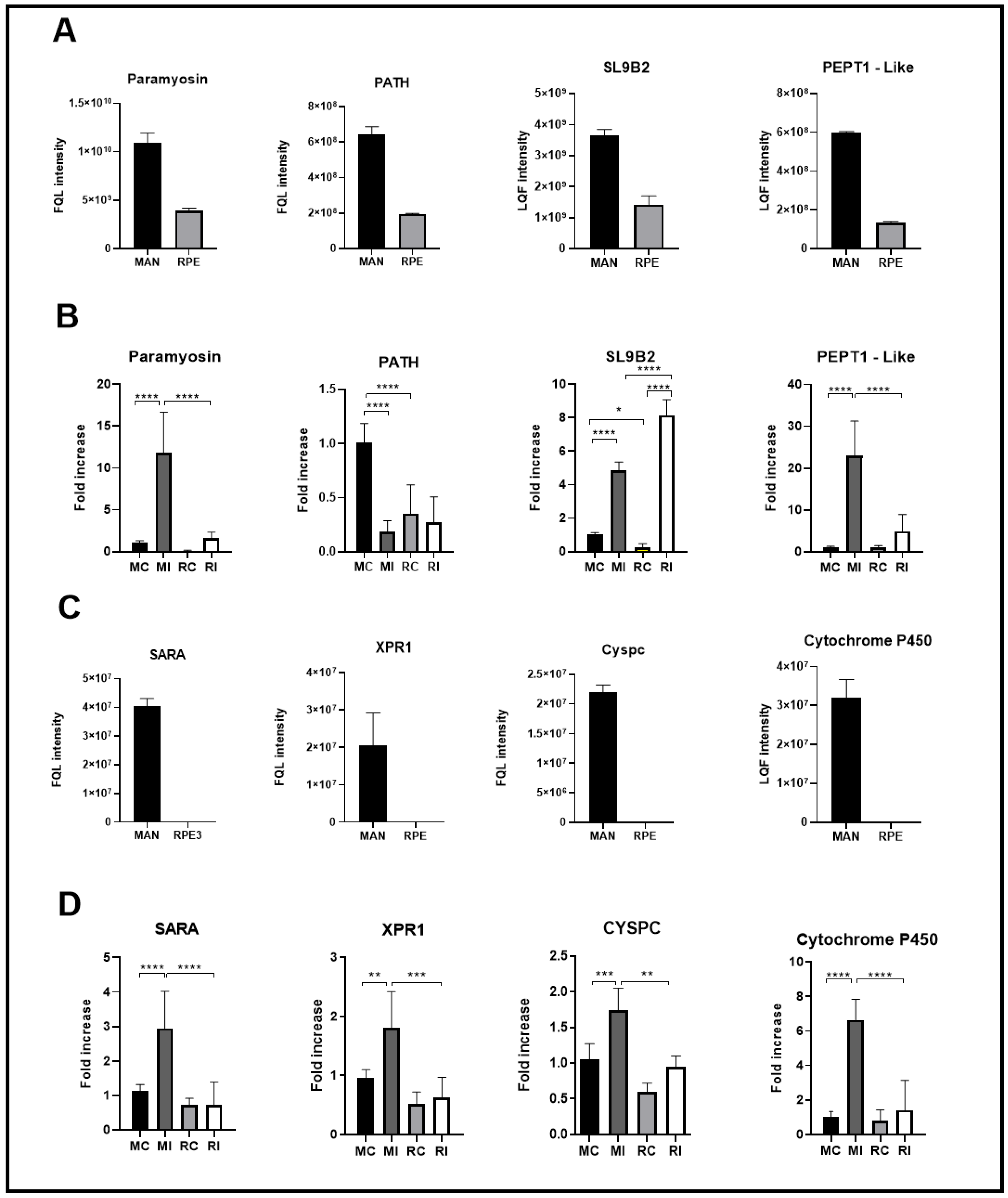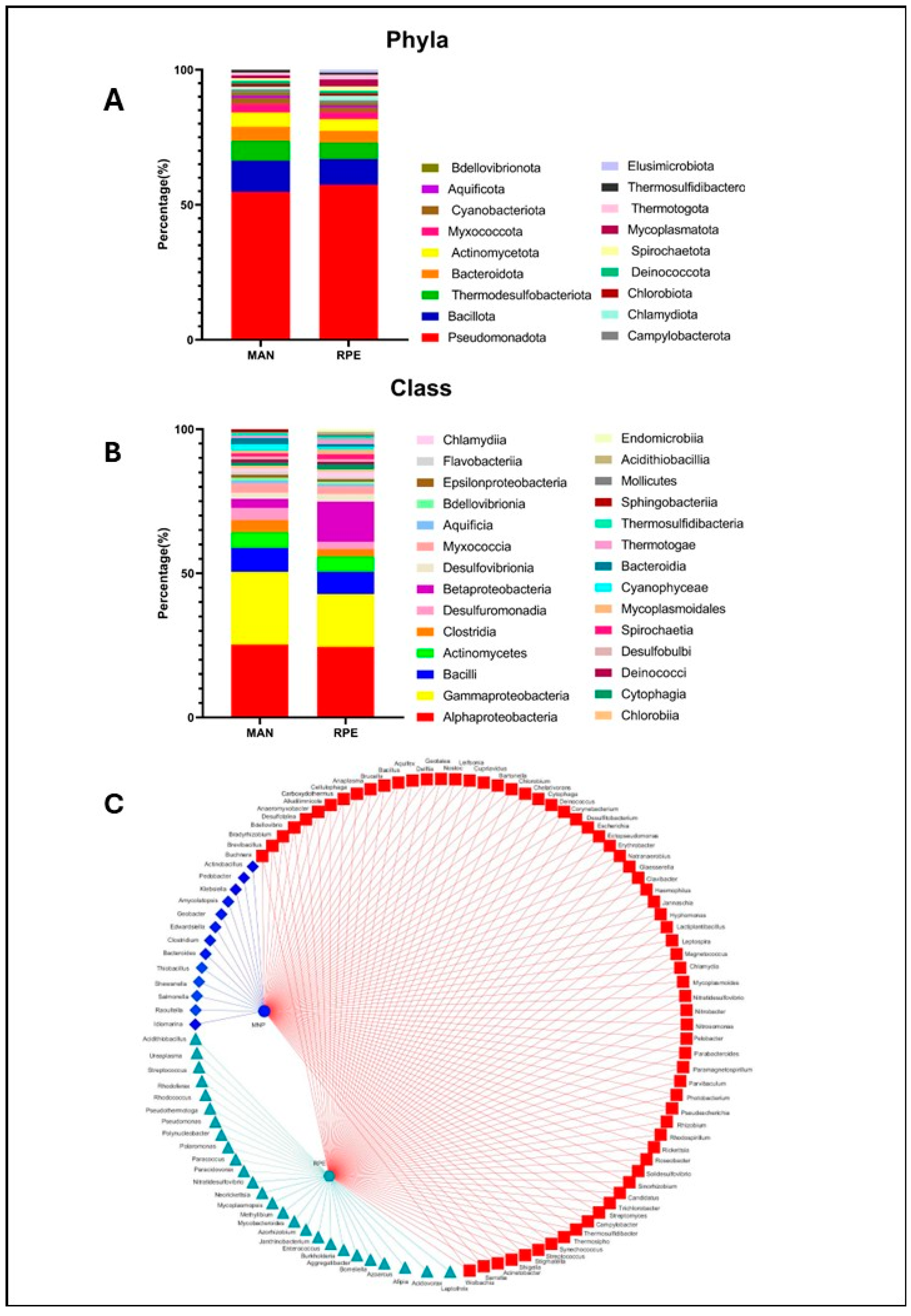Comparative Gut Proteome of Nyssomyia umbratilis from Leishmaniasis Endemic and Non-Endemic Areas of Amazon Reveals Differences in Microbiota and Proteins Related to Immunity and Gut Function
Abstract
1. Introduction
2. Material and Methods
2.1. Sand Flies
2.2. Mass Spectrometry Analysis
2.3. Protein Identification and Quantitation
2.4. Metaproteomic Analysis
2.4.1. Peptide Spectrum Matching (PSM)
2.4.2. Validation of PSMs
2.4.3. RNA Isolation from N. umbratilis
2.4.4. cDNA Synthesis
2.4.5. Real-Time qPCR
2.5. Statistical Analysis
3. Results
3.1. N. umbratilis Gut Proteome Analysis
3.2. Differentially and Exclusively Identified Proteins
3.3. Putative Protein–Protein Interaction Networks of Differentially Identified Peptides
3.4. Transcriptional Levels of Genes Coding for Proteins Differentially and Exclusively Identified in N. umbratilis from MAN
3.5. Metaproteomic Analysis
4. Discussion
Supplementary Materials
Author Contributions
Funding
Institutional Review Board Statement
Informed Consent Statement
Data Availability Statement
Acknowledgments
Conflicts of Interest
References
- Ryan, L.; Lainson, R.; Shaw, J.J. Leishmaniasis in Brazil. XXIV. Natural flagellate infections of sandflies (Diptera: Psychodidae) in Pará State, with particular reference to the rôle of Psychodopygus wellcomei as the vector of Leishmania braziliensis braziliensis in the Serra dos Carajás. Trans. R. Soc. Trop. Med. Hyg. 1987, 81, 353–359. [Google Scholar] [CrossRef] [PubMed]
- Azim, M.; Khan, S.A.; Ullah, S.; Ullah, S.; Anjum, S.I. Therapeutic advances in the topical treatment of cutaneous leishmaniasis: A review. PLoS Neglected Trop. Dis. 2021, 15, e0009099. [Google Scholar] [CrossRef] [PubMed] [PubMed Central]
- Arias, J.R.; Freitas, R.A. On the vectors of cutaneus Leishmaniasis in Central Amazon of Brazil. Acta Amaz. 1977, 7, 293–294. [Google Scholar] [CrossRef][Green Version]
- Justiniano, S.C.; Chagas, A.C.; Pessoa, F.A.; Queiroz, R.G. Comparative biology of two populations of Lutzomyia umbratilis (Diptera: Psychodidae) of Central Amazonia, Brazil, under laboratory conditions. Braz. J. Biol. 2004, 64, 227–235. [Google Scholar] [CrossRef] [PubMed]
- Scarpassa, V.M.; Alencar, R.B. Molecular taxonomy of the two Leishmania vectors Lutzomyia umbratilis and Lutzomyia anduzei (Diptera: Psychodidae) from the Brazilian Amazon. Parasites Vectors 2013, 6, 258. [Google Scholar] [CrossRef] [PubMed] [PubMed Central][Green Version]
- Scarpassa, V.M.; Cunha-Machado, A.S.; Alencar, R.B. Multiple evolutionary lineages for the main vector of Leishmania guyanensis, Lutzomyia umbratilis (Diptera: Psychodidae), in the Brazilian Amazon. Sci. Rep. 2021, 11, 15323, Erratum in Sci. Rep. 2021, 11, 17176. [Google Scholar] [CrossRef] [PubMed] [PubMed Central]
- Soares, R.P.; Nogueira, P.M.; Secundino, N.F.; Marialva, E.F.; Ríos-Velásquez, C.M.; Pessoa, F.A.C. Lutzomyia umbratilis from an area south of the Negro River is refractory to in vitro interaction with Leishmania guyanensis. Mem. Inst. Oswaldo Cruz 2018, 113, 202–205. [Google Scholar] [CrossRef] [PubMed] [PubMed Central]
- Tom, A.; Kumar, N.P.; Kumar, A.; Saini, P. Interactions between Leishmania parasite and sandfly: A review. Parasitol. Res. 2023, 123, 6. [Google Scholar] [CrossRef] [PubMed]
- Li, G.J.; Dong, Q.E.; Ma, L.; Huang, Y.; Zhu, M.L.; Ji, Y.P.; Wang, Q.H.; Mo, M.H.; Zhang, K.Q. Management of Meloidogyne incognita on tomato with endophytic bacteria and fresh residue of Wasabia japonica. J. Appl. Microbiol. 2014, 117, 1159–1167. [Google Scholar] [CrossRef] [PubMed]
- Santos Ferreira, D.A.; de Castro Levatti, E.V.; Santa Cruz, L.M.; Costa, A.R.; Migotto, Á.E.; Yamada, A.Y.; Camargo, C.H.; Christodoulides, M.; Lago, J.H.G.; Tempone, A.G. Saturated Iso-Type Fatty Acids from the Marine Bacterium Mesoflavibacter zeaxanthinifaciens with Anti-Trypanosomal Potential. Pharmaceuticals 2024, 17, 499. [Google Scholar] [CrossRef] [PubMed] [PubMed Central]
- Cox, J.; Mann, M. MaxQuant enables high peptide identification rates, individualized p.p.b.-range mass accuracies and proteome-wide protein quantification. Nat. Biotechnol. 2008, 26, 1367–1372. [Google Scholar] [CrossRef] [PubMed]
- Cox, J.; Neuhauser, N.; Michalski, A.; Scheltema, R.A.; Olsen, J.V.; Mann, M. Andromeda: A peptide search engine integrated into the MaxQuant environment. J. Proteome Res. 2011, 10, 1794–1805. [Google Scholar] [CrossRef] [PubMed]
- Luber, C.A.; Cox, J.; Lauterbach, H.; Fancke, B.; Selbach, M.; Tschopp, J.; Akira, S.; Wiegand, M.; Hochrein, H.; O’Keeffe, M.; et al. Quantitative proteomics reveals subset-specific viral recognition in dendritic cells. Immunity 2010, 32, 279–289. [Google Scholar] [CrossRef] [PubMed]
- Santos, M.D.M.; Lima, D.B.; Fischer, J.S.G.; Clasen, M.A.; Kurt, L.U.; Camillo-Andrade, A.C.; Monteiro, L.C.; de Aquino, P.F.; Neves-Ferreira, A.G.C.; Valente, R.H.; et al. Simple, efficient and thorough shotgun proteomic analysis with PatternLab V. Nat. Protoc. 2022, 17, 1553–1578. [Google Scholar] [CrossRef] [PubMed]
- Carvalho, P.C.; Fischer, J.S.; Xu, T.; Cociorva, D.; Balbuena, T.S.; Valente, R.H.; Perales, J.; Yates, J.R., 3rd; Barbosa, V.C. Search engine processor: Filtering and organizing peptide spectrum matches. Proteomics 2012, 12, 944–949. [Google Scholar] [CrossRef] [PubMed] [PubMed Central]
- Barboza, R.; Cociorva, D.; Xu, T.; Barbosa, V.C.; Perales, J.; Valente, R.H.; França, F.M.; Yates, J.R., 3rd; Carvalho, P.C. Can the false-discovery rate be misleading? Proteomics 2011, 11, 4105–4108. [Google Scholar] [CrossRef] [PubMed] [PubMed Central]
- Yates, J.R., 3rd; Park, S.K.; Delahunty, C.M.; Xu, T.; Savas, J.N.; Cociorva, D.; Carvalho, P.C. Toward objective evaluation of proteomic algorithms. Nat. Methods 2012, 9, 455–456. [Google Scholar] [CrossRef] [PubMed] [PubMed Central]
- Ross, A.; Willson, V.L. One-Way Anova. In Basic and Advanced Statistical Tests; Sense Publishers: Rotterdam, Holland, 2017. [Google Scholar] [CrossRef]
- Boll, M.; Daniel, H.; Gasnier, B. The SLC36 family: Proton-coupled transporters for the absorption of selected amino acids from extracellular and intracellular proteolysis. Pflügers Arch. 2004, 447, 776–779. [Google Scholar] [CrossRef] [PubMed]
- Wang, C.Y.; Liu, S.; Xie, X.N.; Tan, Z.R. Regulation profile of the intestinal peptide transporter 1 (PepT1). Drug Des. Dev. Ther. 2017, 11, 3511–3517. [Google Scholar] [CrossRef] [PubMed] [PubMed Central]
- Chintapalli, V.R.; Kato, A.; Henderson, L.; Hirata, T.; Woods, D.J.; Overend, G.; Davies, S.A.; Romero, M.F.; Dow, J.A. Transport proteins NHA1 and NHA2 are essential for survival but have distinct transport modalities. Proc. Natl. Acad. Sci. USA 2015, 112, 11720–11725. [Google Scholar] [CrossRef] [PubMed] [PubMed Central]
- Beinbrech, G.; Meller, U.; Sasse, W. Paramyosin content and thick filament structure in insect muscles. Cell Tissue Res. 1985, 241, 607–614. [Google Scholar] [CrossRef]
- Tang, W.B.; Ling, G.H.; Sun, L.; Liu, F.Y. Smad anchor for receptor activation (SARA) in TGF-beta signaling. Front. Biosci. 2010, 2, 857–860. [Google Scholar] [CrossRef] [PubMed]
- Di-Blasi, T.; Telleria, E.L.; Marques, C.; Couto, R.M.; da Silva-Neves, M.; Jancarova, M.; Volf, P.; Tempone, A.J.; Traub-Csekö, Y.M. Lutzomyia longipalpis TGF-β Has a Role in Leishmania infantum chagasi Survival in the Vector. Front. Cell Infect. Microbiol. 2019, 9, 71. [Google Scholar] [CrossRef] [PubMed] [PubMed Central]
- Vaughan, A.E.; Mendoza, R.; Aranda, R.; Battini, J.L.; Miller, A.D. Xpr1 is an atypical G-protein-coupled receptor that mediates xenotropic and polytropic murine retrovirus neurotoxicity. J. Virol. 2012, 86, 1661–1669. [Google Scholar] [CrossRef] [PubMed] [PubMed Central]
- Adams, E.R.; Gomez, M.A.; Scheske, L.; Rios, R.; Marquez, R.; Cossio, A.; Albertini, A.; Schallig, H.; Saravia, N.G. Sensitive diagnosis of cutaneous leishmaniasis by lesion swab sampling coupled to qPCR. Parasitology 2014, 141, 1891–1897. [Google Scholar] [CrossRef] [PubMed] [PubMed Central]
- Guzmán, V.; Carmona-Fonseca, J. El citocromo P-450 y la respuesta terapéutica a los antimaláricos [Cytochrome P-450 and the response to antimalarial drugs]. Rev. Panam. De Salud Pública 2006, 19, 9–22. (In Spanish) [Google Scholar] [CrossRef] [PubMed][Green Version]
- Szklarczyk, D.; Kirsch, R.; Koutrouli, M.; Nastou, K.; Mehryary, F.; Hachilif, R.; Gable, A.L.; Fang, T.; Doncheva, N.T.; Pyysalo, S.; et al. The STRING database in 2023: Protein-protein association networks and functional enrichment analyses for any sequenced genome of interest. Nucleic Acids Res. 2023, 51, D638–D646. [Google Scholar] [CrossRef] [PubMed] [PubMed Central]
- Ge, S.X.; Jung, D.; Yao, R. ShinyGO: A graphical gene-set enrichment tool for animals and plants. Bioinformatics 2020, 36, 2628–2629. [Google Scholar] [CrossRef]
- Metwally, E.; Zhao, G.; Wang, Q.; Zhang, Y.Q. Ttm50 facilitates calpain activation by anchoring it to calcium stores and increasing its sensitivity to calcium. Cell Res. 2021, 31, 433–449. [Google Scholar] [CrossRef] [PubMed] [PubMed Central]
- Guzmán, L.F.; Tirado, B.; Cruz-Cárdenas, C.I.; Rojas-Anaya, E.; Aragón-Magadán, M.A. De Novo Transcriptome Assembly of Cedar (Cedrela odorata L.) and Differential Gene Expression Involved in Herbivore Resistance. Curr. Issues Mol. Biol. 2024, 46, 8794–8806. [Google Scholar] [CrossRef] [PubMed] [PubMed Central]
- Souza Freitas, M.T.; Ríos-Velasquez, C.M.; Costa, C.R., Jr.; Figueirêdo, C.A., Jr.; Aragão, N.C.; da Silva, L.G.; de Aragão Batista, M.V.; Balbino, T.C.; Pessoa, F.A.; de Queiroz Balbino, V. Phenotypic and genotypic variations among three allopatric populations of Lutzomyia umbratilis, main vector of Leishmania guyanensis. Parasites Vectors 2015, 8, 448. [Google Scholar] [CrossRef] [PubMed] [PubMed Central]
- Wilson, R.; Bates, M.D.; Dostalova, A.; Jecna, L.; Dillon, R.J.; Volf, P.; Bates, P.A. Stage-specific adhesion of Leishmania promastigotes to sand fly midguts assessed using an improved comparative binding assay. PLoS Neglected Trop. Dis. 2010, 4, e816. [Google Scholar] [CrossRef] [PubMed] [PubMed Central]
- Yanase, R.; Pruzinova, K.; Owino, B.O.; Rea, E.; Moreira-Leite, F.; Taniguchi, A.; Nonaka, S.; Sádlová, J.; Vojtkova, B.; Volf, P.; et al. Discovery of essential kinetoplastid-insect adhesion proteins and their function in Leishmania-sand fly interactions. Nat. Commun. 2024, 15, 6960. [Google Scholar] [CrossRef] [PubMed] [PubMed Central]
- Lawyer, P.G.; Young, D.G.; Butler, J.F.; Akin, D.E. Development of Leishmania mexicana in Lutzomyia diabolica and Lutzomyia shannoni (Diptera: Psychodidae). J. Med. Entomol. 1987, 24, 347–355. [Google Scholar] [CrossRef] [PubMed]
- Sant’Anna, M.R.; Diaz-Albiter, H.; Aguiar-Martins, K.; Al Salem, W.S.; Cavalcante, R.R.; Dillon, V.M.; Bates, P.A.; Genta, F.A.; Dillon, R.J. Colonisation resistance in the sand fly gut: Leishmania protects Lutzomyia longipalpis from bacterial infection. Parasites Vectors 2014, 7, 329. [Google Scholar] [CrossRef] [PubMed] [PubMed Central]
- Bafghi, A.F.; Eslami, G.; Ajamein, V.; Barzegar, K.; Vakili, M. Expression profile in Leishmania major exposed to Staphylococcus aureus and group A beta-hemolytic Streptococcus. J. Vector Borne Dis. 2023, 60, 32–37. [Google Scholar] [CrossRef] [PubMed]
- Kamato, D.; Burch, M.L.; Piva, T.J.; Rezaei, H.B.; Rostam, M.A.; Xu, S.; Zheng, W.; Little, P.J.; Osman, N. Transforming growth factor-β signalling: Role and consequences of Smad linker region phosphorylation. Cell Signal. 2013, 25, 2017–2024. [Google Scholar] [CrossRef] [PubMed]
- Rozés-Salvador, V.; Siri, S.O.; Musri, M.M.; Conde, C. New Player in Endosomal Trafficking: Differential Roles of Smad Anchor for Receptor Activation (SARA) Protein. Mol. Cell. Biol. 2018, 38, e00446-18. [Google Scholar] [CrossRef] [PubMed] [PubMed Central]
- Nepomuceno, D.B.; Paim, R.M.M.; Araújo, R.N.; Pereira, M.H.; Pessoa, G.C.D.; Koerich, L.B.; Sant’Anna, M.R.V.; Gontijo, N.F. The role of LuloPAT amino acid/proton symporters in midgut alkalinization in the sandfly Lutzomyia longipalpis (Diptera—Psychodidae). J. Insect Physiol. 2020, 120, 103973. [Google Scholar] [CrossRef] [PubMed]
- Nepomuceno, D.B.; D’Ávila Pessoa, G.C.; Koerich, L.B.; Pereira, M.H.; Sant’Anna, M.R.V.; Araújo, R.N.; Gontijo, N.F. cAMP: A second messenger involved in the mechanism of midgut alkalinization in Lutzomyia longipalpis. Insect Sci. 2022, 29, 1059–1070. [Google Scholar] [CrossRef] [PubMed]
- Newstead, S. Molecular insights into proton coupled peptide transport in the PTR family of oligopeptide transporters. Biochim. Et Biophys. Acta 2015, 1850, 488–499. [Google Scholar] [CrossRef] [PubMed] [PubMed Central]
- Bates, P.A.; Tetley, L. Leishmania mexicana: Induction of metacyclogenesis by cultivation of promastigotes at acidic pH. Exp. Parasitol. 1993, 76, 412–423. [Google Scholar] [CrossRef] [PubMed]
- Zakai, H.A.; Chance, M.L.; Bates, P.A. In vitro stimulation of metacyclogenesis in Leishmania braziliensis, L. donovani, L. major and L. mexicana. Parasitology 1998, 116, 305–309. [Google Scholar] [CrossRef] [PubMed]
- Noronha, F.S.; Nunes, A.C.; Souza, K.T.; Melo, M.N.; Ramalho-Pinto, F.J. Differential sensitivity of New World Leishmania spp. promastigotes to complement-mediated lysis: Correlation with the expression of three parasite polypeptides. Acta Trop. 1998, 69, 17–29. [Google Scholar] [CrossRef] [PubMed]
- Barros, V.C.; Assumpção, J.G.; Cadete, A.M.; Santos, V.C.; Cavalcante, R.R.; Araújo, R.N.; Pereira, M.H.; Gontijo, N.F. The role of salivary and intestinal complement system inhibitors in the midgut protection of triatomines and mosquitoes. PLoS ONE 2009, 4, e6047. [Google Scholar] [CrossRef] [PubMed] [PubMed Central]
- Vaidyanathan, R. Isolation of a myoinhibitory peptide from Leishmania major (Kinetoplastida: Trypanosomatidae) and its function in the vector sand fly Phlebotomus papatasi (Diptera: Psychodidae). J. Med. Entomol. 2005, 42, 142–152. [Google Scholar] [CrossRef] [PubMed]
- Vaidyanathan, R. Leishmania parasites (Kinetoplastida: Trypanosomatidae) reversibly inhibit visceral muscle contractions in hemimetabolous and holometabolous insects. J. Invertebr. Pathol. 2004, 87, 123–128. [Google Scholar] [CrossRef] [PubMed]
- Shamjana, U.; Vasu, D.A.; Hembrom, P.S.; Nayak, K.; Grace, T. The role of insect gut microbiota in host fitness, detoxification and nutrient supplementation. Antonie Van. Leeuwenhoek 2024, 117, 71. [Google Scholar] [CrossRef] [PubMed]
- Taracena-Agarwal, M.L.; Hixson, B.; Nandakumar, S.; Girard-Mejia, A.P.; Chen, R.Y.; Huot, L.; Padilla, N.; Buchon, N. The midgut epithelium of mosquitoes adjusts cell proliferation and endoreplication to respond to physiological challenges. BMC Biol. 2024, 22, 22. [Google Scholar] [CrossRef] [PubMed] [PubMed Central]
- Kakumanu, M.L.; Marayati, B.F.; Wada-Katsumata, A.; Wasserberg, G.; Schal, C.; Apperson, C.S.; Ponnusamy, L. Sphingobacterium phlebotomi sp. nov., a new member of family Sphingobacteriaceae isolated from sand fly rearing substrate. Int. J. Syst. Evol. Microbiol. 2021, 71, 004809. [Google Scholar] [CrossRef] [PubMed] [PubMed Central]
- Huang, W.; Rodrigues, J.; Bilgo, E.; Tormo, J.R.; Challenger, J.D.; De Cozar-Gallardo, C.; Pérez-Victoria, I.; Reyes, F.; Castañeda-Casado, P.; Gnambani, E.J.; et al. Delftia tsuruhatensis TC1 symbiont suppresses malaria transmission by anopheline mosquitoes. Science 2023, 381, 533–540. [Google Scholar] [CrossRef] [PubMed]
- Gao, H.; Bai, L.; Jiang, Y.; Huang, W.; Wang, L.; Li, S.; Zhu, G.; Wang, D.; Huang, Z.; Li, X.; et al. A natural symbiotic bacterium drives mosquito refractoriness to Plasmodium infection via secretion of an antimalarial lipase. Nat. Microbiol. 2021, 6, 806–817. [Google Scholar] [CrossRef] [PubMed] [PubMed Central]
- Peterkova-Koci, K.; Robles-Murguia, M.; Ramalho-Ortigao, M.; Zurek, L. Significance of bacteria in oviposition and larval development of the sand fly Lutzomyia longipalpis. Parasites Vectors 2012, 5, 145. [Google Scholar] [CrossRef] [PubMed] [PubMed Central]
- Amni, F.; Maleki-Ravasan, N.; Nateghi-Rostami, M.; Hadighi, R.; Karimian, F.; Meamar, A.R.; Badirzadeh, A.; Parvizi, P. Corrigendum: Co-infection of Phlebotomus papatasi (Diptera: Psychodidae) gut bacteria with Leishmania major exacerbates the pathological responses of BALB/c mice. Front. Cell Infect. Microbiol. 2023, 13, 1185912, Erratum in Front. Cell Infect. Microbiol. 2023, 13, 1115542. [Google Scholar] [CrossRef] [PubMed] [PubMed Central]
- Kelly, P.H.; Bahr, S.M.; Serafim, T.D.; Ajami, N.J.; Petrosino, J.F.; Meneses, C.; Kirby, J.R.; Valenzuela, J.G.; Kamhawi, S.; Wilson, M.E. The Gut Microbiome of the Vector Lutzomyia longipalpis Is Essential for Survival of Leishmania infantum. mBio 2017, 8, e01121-16. [Google Scholar] [CrossRef] [PubMed] [PubMed Central]
- Louradour, I.; Monteiro, C.C.; Inbar, E.; Ghosh, K.; Merkhofer, R.; Lawyer, P.; Paun, A.; Smelkinson, M.; Secundino, N.; Lewis, M.; et al. The midgut microbiota plays an essential role in sand fly vector competence for Leishmania major. Cell. Microbiol. 2017, 19, e12755. [Google Scholar] [CrossRef] [PubMed] [PubMed Central]
- Karimian, F.; Koosha, M.; Choubdar, N.; Oshaghi, M.A. Comparative analysis of the gut microbiota of sand fly vectors of zoonotic visceral leishmaniasis (ZVL) in Iran; host-environment interplay shapes diversity. PLoS Neglected Trop. Dis. 2022, 16, e0010609. [Google Scholar] [CrossRef] [PubMed] [PubMed Central]
- Telleria, E.L.; Martins-da-Silva, A.; Tempone, A.J.; Traub-Csekö, Y.M. Leishmania, microbiota and sand fly immunity. Parasitology 2018, 145, 1336–1353. [Google Scholar] [CrossRef] [PubMed] [PubMed Central]
- Desai, M.S.; Brune, A. Bacteroidales ectosymbionts of gut flagellates shape the nitrogen-fixing community in dry-wood termites. ISME J. 2012, 6, 1302–1313. [Google Scholar] [CrossRef] [PubMed] [PubMed Central]





| Primer | Sequence 5′–3′ |
|---|---|
| GAPDH-F | TTC GCA GAA GAC AGT GATG G |
| GAPDH-R | CCC TTC ATC GGT CTG GAC TA |
| SL9B2-F | AGCCACCGACCATCCCT |
| SL9B2-R | TTTGTGACCGTGAAGACG |
| PATH-F | AACTACACCATGAGGAC |
| PATH-R | TCCCAGTACGTGACCAT |
| PEPT1-LIKE-F | CCTCCAAGATATACACGATGATT |
| PEPT1-LIKE-R | CTCCCAATCTCAATTCATA |
| PARAMYOSIN-F | ATCGACAGGAGGCGGAAG |
| PARAMYOSIN-R | TTCAATCCTCTGACGAAG |
| SARA-F | ACTACCGCTACTACCCGAG |
| SARA-R | CACGAATGGATGAAAG |
| XPR1-F | CTACTACTTTGCCATT |
| XPR1-R | CCAGAGGAGCCGTTAT |
| CYSPC-F | TGCTGAGAATCCACAGTTT |
| CYSPC-R | CCTTCCTGCCATCATT |
| CYTOCHROME P450-F | TAGGAAGATGGGAAGGAAG |
| CYTOCHROME P450-R | CTTTATCCACTGTTTTCAC |
Disclaimer/Publisher’s Note: The statements, opinions and data contained in all publications are solely those of the individual author(s) and contributor(s) and not of MDPI and/or the editor(s). MDPI and/or the editor(s) disclaim responsibility for any injury to people or property resulting from any ideas, methods, instructions or products referred to in the content. |
© 2025 by the authors. Licensee MDPI, Basel, Switzerland. This article is an open access article distributed under the terms and conditions of the Creative Commons Attribution (CC BY) license (https://creativecommons.org/licenses/by/4.0/).
Share and Cite
Tempone, A.J.; Spelta, G.I.; Ramos de Almeida, V.; Giglioti, D.M.; Costa, E.M.; Mathias, I.; Vargas, H.; Lemos-Silva, T.; Ribeiro, A.C.P.d.S.; Marialva, E.F.; et al. Comparative Gut Proteome of Nyssomyia umbratilis from Leishmaniasis Endemic and Non-Endemic Areas of Amazon Reveals Differences in Microbiota and Proteins Related to Immunity and Gut Function. Microorganisms 2025, 13, 1304. https://doi.org/10.3390/microorganisms13061304
Tempone AJ, Spelta GI, Ramos de Almeida V, Giglioti DM, Costa EM, Mathias I, Vargas H, Lemos-Silva T, Ribeiro ACPdS, Marialva EF, et al. Comparative Gut Proteome of Nyssomyia umbratilis from Leishmaniasis Endemic and Non-Endemic Areas of Amazon Reveals Differences in Microbiota and Proteins Related to Immunity and Gut Function. Microorganisms. 2025; 13(6):1304. https://doi.org/10.3390/microorganisms13061304
Chicago/Turabian StyleTempone, Antonio Jorge, Guilherme Ian Spelta, Victor Ramos de Almeida, Daniel Machado Giglioti, Erika Moutinho Costa, Izabela Mathias, Helena Vargas, Thais Lemos-Silva, Ana Carolina Pedro dos Santos Ribeiro, Eric Fabrício Marialva, and et al. 2025. "Comparative Gut Proteome of Nyssomyia umbratilis from Leishmaniasis Endemic and Non-Endemic Areas of Amazon Reveals Differences in Microbiota and Proteins Related to Immunity and Gut Function" Microorganisms 13, no. 6: 1304. https://doi.org/10.3390/microorganisms13061304
APA StyleTempone, A. J., Spelta, G. I., Ramos de Almeida, V., Giglioti, D. M., Costa, E. M., Mathias, I., Vargas, H., Lemos-Silva, T., Ribeiro, A. C. P. d. S., Marialva, E. F., Rios-Velasquez, C., Batista, M., Santos, M. D. M. d., Pessoa, F. A. C., & Traub-Csekö, Y. M. (2025). Comparative Gut Proteome of Nyssomyia umbratilis from Leishmaniasis Endemic and Non-Endemic Areas of Amazon Reveals Differences in Microbiota and Proteins Related to Immunity and Gut Function. Microorganisms, 13(6), 1304. https://doi.org/10.3390/microorganisms13061304








